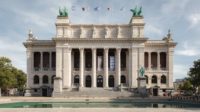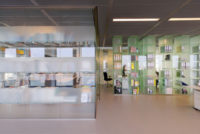Built in 1917 by the chief government architect Daniel E.C. Knuttel for the Dutch Ministry of Agriculture, Industry and Trade in The Hague, the brick and stone building at Bezuidenhoutseweg 30 has been transformed by the Rotterdam-based Kaan Architecten into a home for five government-related planning and advisory agencies. The once dark and heavy interiors of this national landmark are now light and transparent, and, in keeping with the changing times, B30, named after its address, is ready to facilitate an exchange of knowledge rather than the exercise of power.
An open light well enclosed by brick walls once connected the two wings of the original H-shaped structure. In 1994, during an expansion, the light well was turned into a 98-foot-high atrium lined by three additional floors of offices. Since the current tenants need less space, Kaan removed these floors—which were in bad condition and had low ceilings—reducing by 33 feet the height of the atrium. At the same time, the architects refurbished it, surfacing the walls with white plaster and decorating the floor with an expansive terrazzo-mosaic motif designed by Dutch artist Rob Birza. The pattern, says project architect Dikkie Scipio, is like a petrified garden with patterns of flowers in intersecting arcs and circles.
The resulting volume is warm and welcoming, an effect reinforced by two single-story additions on the building’s northeast and southwest elevations. One is sunken and comprises two seminar rooms; the other offers work areas plus an informal lounge furnished with sofas, armchairs, a piano, and coffee bar. Both open to gardens via enormous pivoting glass doors. The ceiling of each, as well as that of the atrium, is punctuated by triangular skylights whose deep, geometric coffers—inspired by the building’s original ceilings—provide daylight minus the glare and heat. And in the building’s rear wing, a new restaurant faces the greenery of the Haagse Bos (the Hague Forest).
Maximizing the spaces flanking the atrium at the upper level, the architects created a pair of open-plan work areas with glazed team rooms and two-person offices, connecting them with bridges across the void. Then they tucked quiet, though transparent, glass-walled offices behind the street-facing facade to the northwest.
Kaan Architecten was part of a consortium, responsible not only for the design and construction, but also for the finance, maintenance, and operation of the building. Design choices were based on the existing decorations.
According to Scipio, “The interior has to last for 30 years. So we used durable and handsome materials, such as oak and a natural stone that resembles the original limestone.” Scipio emphasizes that the approach was “a soft transition” from old to new. For example, replacement lamps were fitted into existing fixtures to light a monumental staircase with stained glass windows featuring scenes from farming and industry.
Getting permission from the Landmarks Commission to put larger windows in the front facade was a major achievement. This was critical to creating a visual connection to the street and to open it up to the public, says Scipio. “The windows are essential to B30’s new mission now that the ground floor is an inviting public space,” says Scipio. “We were asked to make a place that is both stimulating and comfortable and that will attract a younger generation to work here.” Once an expression of hierarchy, B30, the building at Bezuidenhoutseweg 30, now represents a new era of communication for its second hundred years.









Post a comment to this article
Report Abusive Comment